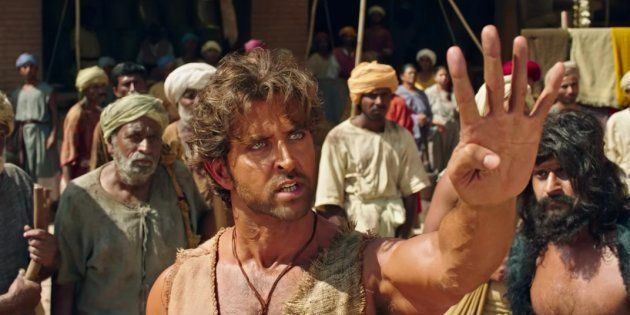
About 20 minutes into Mohenjo Daro, I was surprised at how engrossed I was in the proceedings.
While the trailer for Ashutosh Gowariker's latest period epic, set in the year 2016 BC, had left me (and most people, frankly) unimpressed, I was quite okay with the way its first act was shaping up. Young, handsome, and impossibly chiseled Sarman (Hrithik Roshan) is an orphan who lives with his uncle and aunt in a farming village called Amri, part of modern-day Sindh, but has recurring dreams about the famed city of Mohenjo Daro, where he yearns to go.
An indigo farmer by profession, Sarman somehow has the arms of a warrior (he's introduced in the movie bicep-first, in fact) and demonstrates this right in the beginning, when he wrestles a crocodile and emerges victorious.
Mohenjo Daro on the whole is a lot like this opening set-piece: not very well executed, fatally intent on establishing Roshan as a hero who can do no wrong; but yet, weirdly enough, somewhat effective. Despite a respectable budget at its disposal, it often falters in the special effects department, but Sanjoy Karole's production design, which includes massive structures and props, helps put things back on track.
A disclaimer at the beginning absolves this film of its need to be entirely historically accurate, which gives Gowariker the license to spin a familiar poor-village-boy-meets-privileged-city-girl yarn. So far, so contrived. But as the film hurtles towards its inevitable mother of all set-pieces (There Will Be Flood; heh), the story touches upon multiple themes, ranging from how greed for money and the environment are connected to the virtue of serving citizens as opposed to ruling over them.
That said, there are enough moments of self-sabotage here for one to wonder what Gowariker has been smoking lately. The historical inaccuracies, a subject of much hilarity on social media during the run-up to the film's release, are sure to be dissected in much detail over the next few days. For instance, some of the costumes worn by Chaani (Pooja Hegde), the comely daughter of Mohenjo Daro's head priest (Manish Choudhary), include bejeweled bustiers, backless tops, stylishly slit skirts, and what appeared to be a regular Cotton Cottage sleeveless top (no kidding). Now, I'm no expert, but these — coupled with some very modern-looking dance moves — were anachronistic enough to ruin my viewing experience.
Gowariker's Mohenjo Daro is ruled by the evil Maham (Kabir Bedi), who has built a massive dam on the river Sindhu (now known as Indus). Bedi's booming baritone is as impressive as ever, but his histrionics are all over the place. His son, Moonja (Arunoday Singh), is the Indus Valley equivalent of King Joffrey, only played by a far worse actor. There's a Baahubali-like back-story and a couple of nicely executed fight sequences, but the aforementioned climatic set-piece is robbed of its power somewhat by the aforementioned lack of good CGI. AR Rahman's music, unfortunately, is largely forgettable, although certain orchestral cues work well in some of the film's more rousing sequences (particularly a gladiatorial battle in the film's second half).
All of this could've been ignored to an extent had Gowariker gotten the basics — characterisation, plot development, and acting — bang on. But here we have a pastiche of roughly half-a-dozen movies we're already familiar with as well as the limited acting talents of Roshan, who is sincere but overdoes his trademark facial quiver thing, and the non-existent talents of Hegde, who seems to have only four expressions: happy, sad, confused, and 'turned on by the mere presence of Sarman'. A scene set at a funeral, in which she begins an unbelievably sincere monologue barely a moment after the pyre is lit, is likely to induce uncontrollable giggling.
By the end, when the credits displayed the words 'Written and directed by Ashutosh Gowariker', I felt a little sad. Just a decade ago, Gowariker was the man who made Lagaan (2001) and Swades (2004), one of the masters of the big Indian canvas. Today, one wonders if he should perhaps just go back to the drawing board and re-start from the ground up.
Also see on HuffPost: